tire pressure TOYOTA VERSO S 2014 Owners Manual
[x] Cancel search | Manufacturer: TOYOTA, Model Year: 2014, Model line: VERSO S, Model: TOYOTA VERSO S 2014Pages: 560, PDF Size: 16.94 MB
Page 5 of 560
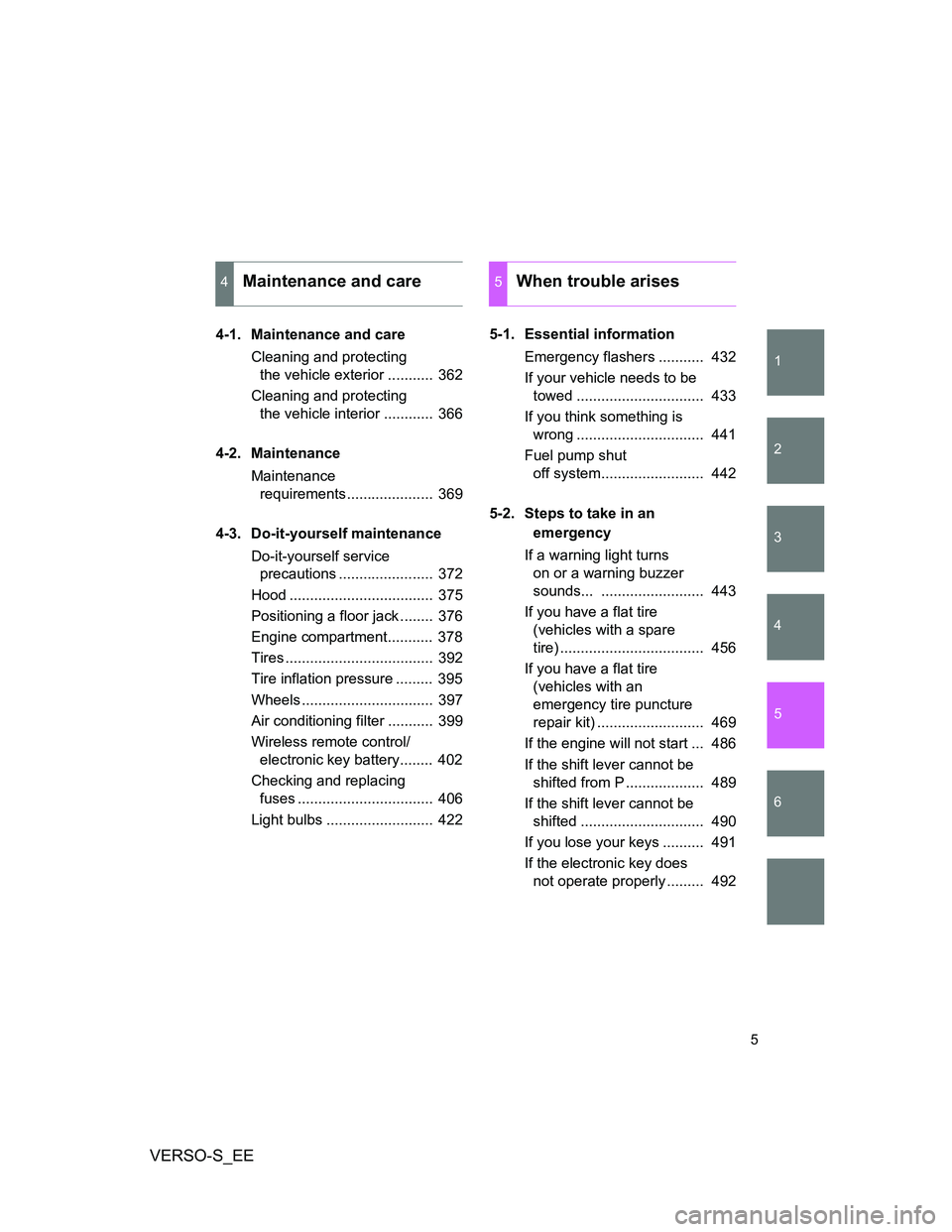
1
2
3
4
5
6
VERSO-S_EE
5
4-1. Maintenance and care
Cleaning and protecting
the vehicle exterior ........... 362
Cleaning and protecting
the vehicle interior ............ 366
4-2. Maintenance
Maintenance
requirements..................... 369
4-3. Do-it-yourself maintenance
Do-it-yourself service
precautions ....................... 372
Hood ................................... 375
Positioning a floor jack ........ 376
Engine compartment........... 378
Tires .................................... 392
Tire inflation pressure ......... 395
Wheels ................................ 397
Air conditioning filter ........... 399
Wireless remote control/
electronic key battery........ 402
Checking and replacing
fuses ................................. 406
Light bulbs .......................... 4225-1. Essential information
Emergency flashers ........... 432
If your vehicle needs to be
towed ............................... 433
If you think something is
wrong ............................... 441
Fuel pump shut
off system......................... 442
5-2. Steps to take in an
emergency
If a warning light turns
on or a warning buzzer
sounds... ......................... 443
If you have a flat tire
(vehicles with a spare
tire) ................................... 456
If you have a flat tire
(vehicles with an
emergency tire puncture
repair kit) .......................... 469
If the engine will not start ... 486
If the shift lever cannot be
shifted from P ................... 489
If the shift lever cannot be
shifted .............................. 490
If you lose your keys .......... 491
If the electronic key does
not operate properly ......... 492
4Maintenance and care5When trouble arises
Page 9 of 560
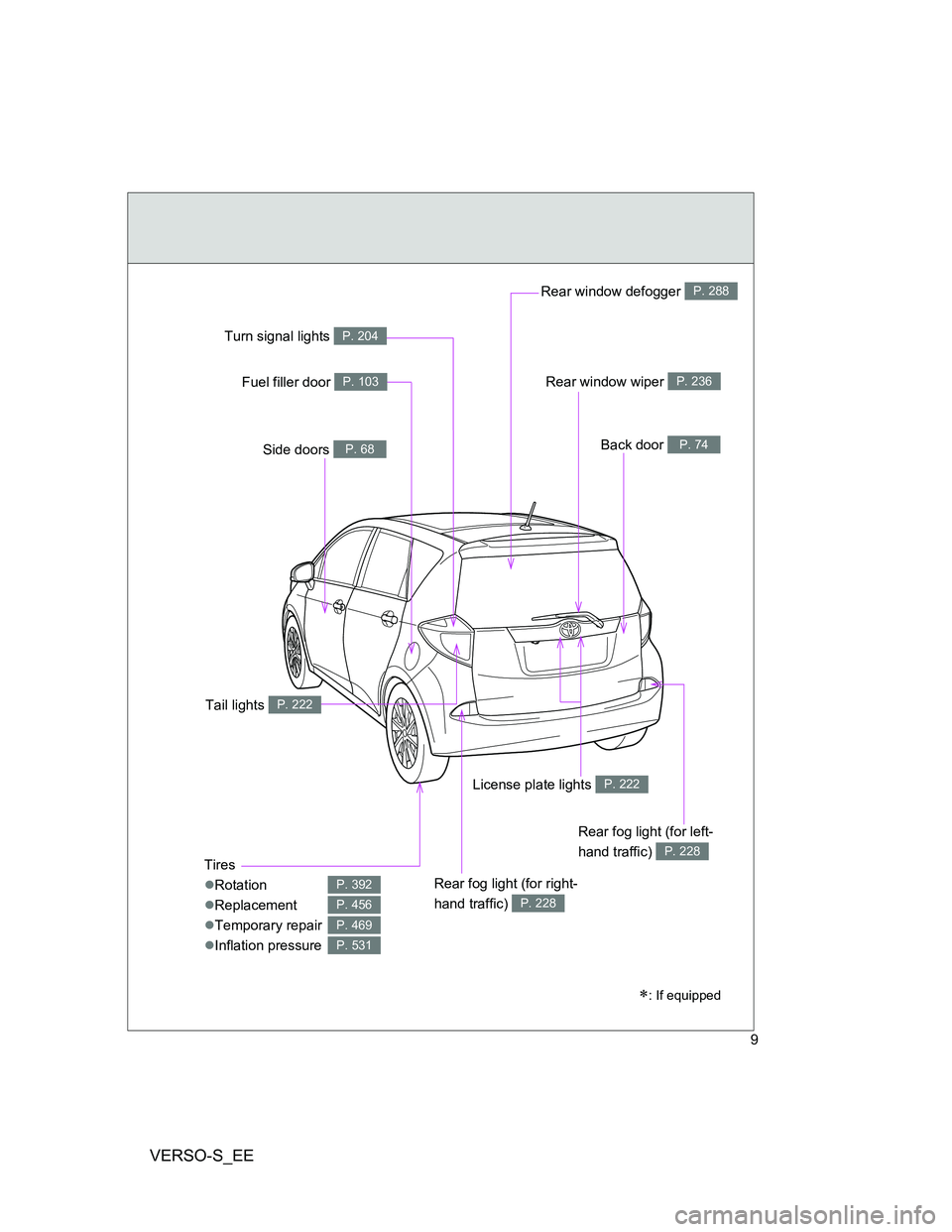
VERSO-S_EE
9
Rear window wiper P. 236
Tires
Rotation
Replacement
Temporary repair
Inflation pressure
P. 392
P. 456
P. 469
P. 531
Back door P. 74Side doors P. 68
Rear window defogger P. 288
License plate lights P. 222
Rear fog light (for right-
hand traffic)
P. 228
Fuel filler door P. 103
Tail lights P. 222
Turn signal lights P. 204
Rear fog light (for left-
hand traffic)
P. 228
: If equipped
Page 254 of 560
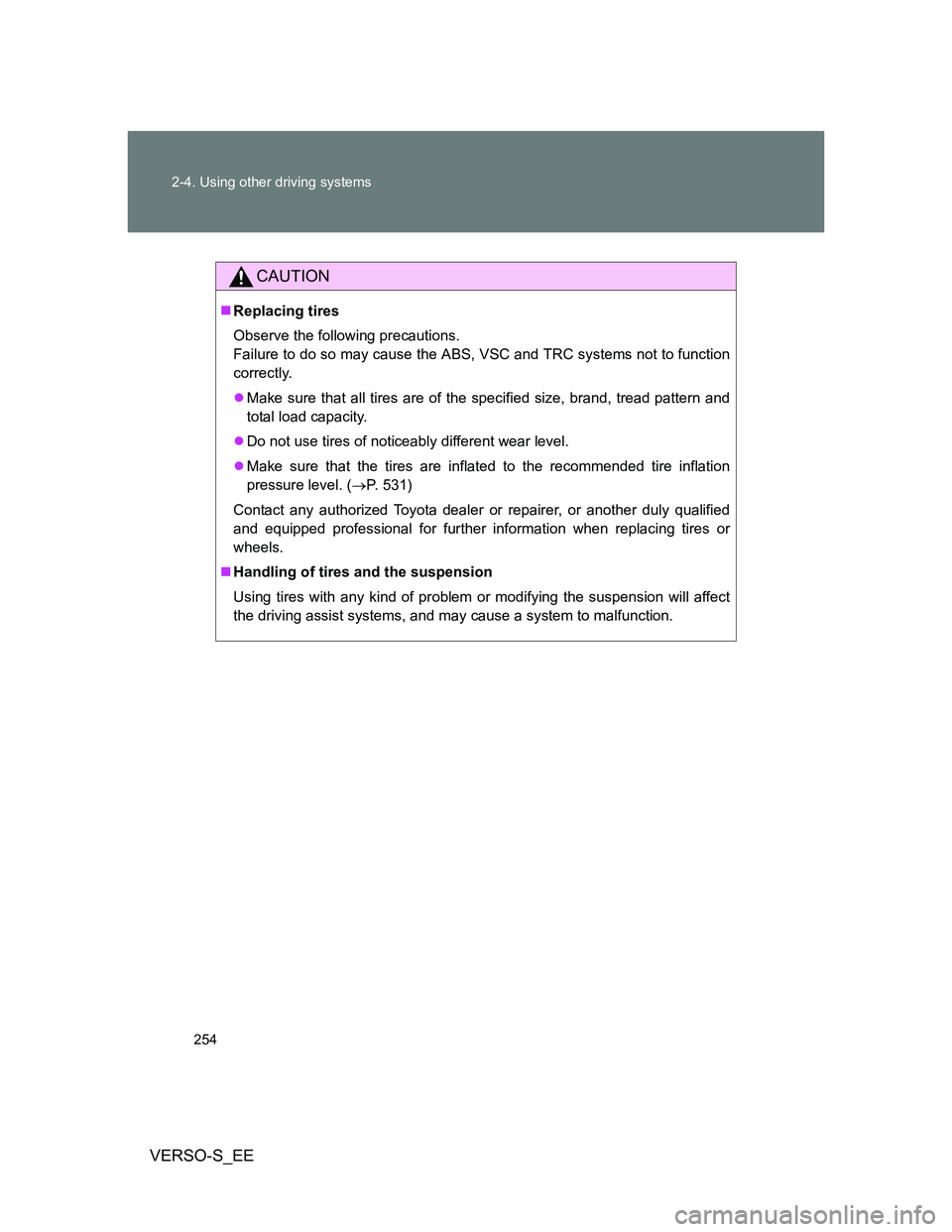
254 2-4. Using other driving systems
VERSO-S_EE
CAUTION
Replacing tires
Observe the following precautions.
Failure to do so may cause the ABS, VSC and TRC systems not to function
correctly.
Make sure that all tires are of the specified size, brand, tread pattern and
total load capacity.
Do not use tires of noticeably different wear level.
Make sure that the tires are inflated to the recommended tire inflation
pressure level. (P. 531)
Contact any authorized Toyota dealer or repairer, or another duly qualified
and equipped professional for further information when replacing tires or
wheels.
Handling of tires and the suspension
Using tires with any kind of problem or modifying the suspension will affect
the driving assist systems, and may cause a system to malfunction.
Page 262 of 560

262 2-5. Driving information
VERSO-S_EE
CAUTION
Driving with snow tires
Observe the following precautions to reduce the risk of accidents.
Failure to do so may result in a loss of vehicle control and cause death or
serious injury.
Use tires of the specified size.
Maintain the recommended level of air pressure.
Do not drive at speeds in excess of the speed limit or the speed limit spec-
ified for the snow tires being used.
Use snow tires on all, not just some wheels.
Do not use tires of noticeably different wear level.
Driving with tire chains
Observe the following precautions to reduce the risk of accidents.
Failure to do so may result in the vehicle being unable to be driven safely,
and may cause death or serious injury.
Do not drive in excess of the speed limit specified for the tire chains being
used, or 50 km/h (30 mph), whichever is lower.
Avoid driving on bumpy road surfaces or over potholes.
Avoid sudden turns and braking, as use of chains may adversely affect
vehicle handling.
Slow down sufficiently before entering a curve to ensure that vehicle con-
trol is maintained.
Page 268 of 560
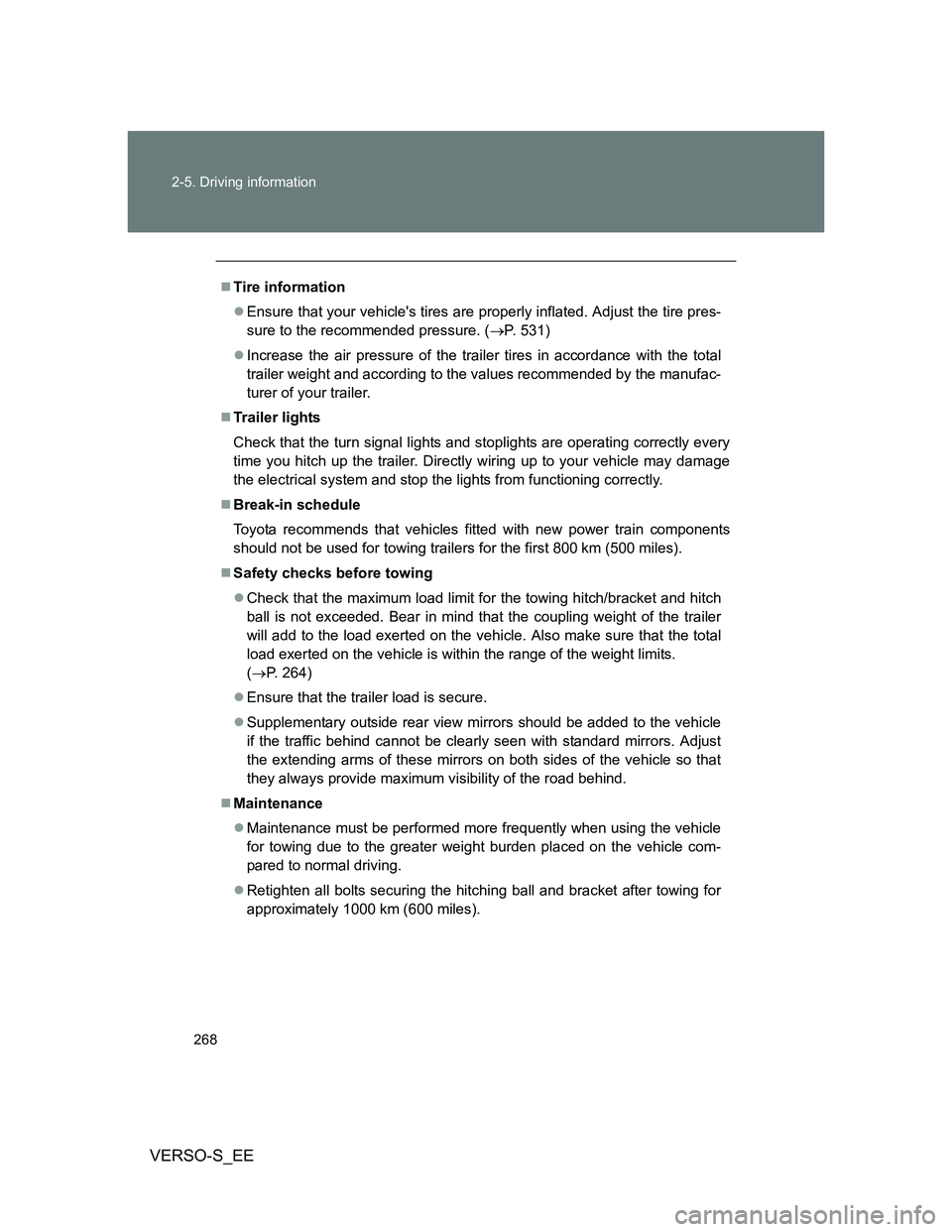
268 2-5. Driving information
VERSO-S_EE
Tire information
Ensure that your vehicle's tires are properly inflated. Adjust the tire pres-
sure to the recommended pressure. (P. 531)
Increase the air pressure of the trailer tires in accordance with the total
trailer weight and according to the values recommended by the manufac-
turer of your trailer.
Trailer lights
Check that the turn signal lights and stoplights are operating correctly every
time you hitch up the trailer. Directly wiring up to your vehicle may damage
the electrical system and stop the lights from functioning correctly.
Break-in schedule
Toyota recommends that vehicles fitted with new power train components
should not be used for towing trailers for the first 800 km (500 miles).
Safety checks before towing
Check that the maximum load limit for the towing hitch/bracket and hitch
ball is not exceeded. Bear in mind that the coupling weight of the trailer
will add to the load exerted on the vehicle. Also make sure that the total
load exerted on the vehicle is within the range of the weight limits.
(P. 264)
Ensure that the trailer load is secure.
Supplementary outside rear view mirrors should be added to the vehicle
if the traffic behind cannot be clearly seen with standard mirrors. Adjust
the extending arms of these mirrors on both sides of the vehicle so that
they always provide maximum visibility of the road behind.
Maintenance
Maintenance must be performed more frequently when using the vehicle
for towing due to the greater weight burden placed on the vehicle com-
pared to normal driving.
Retighten all bolts securing the hitching ball and bracket after towing for
approximately 1000 km (600 miles).
Page 361 of 560
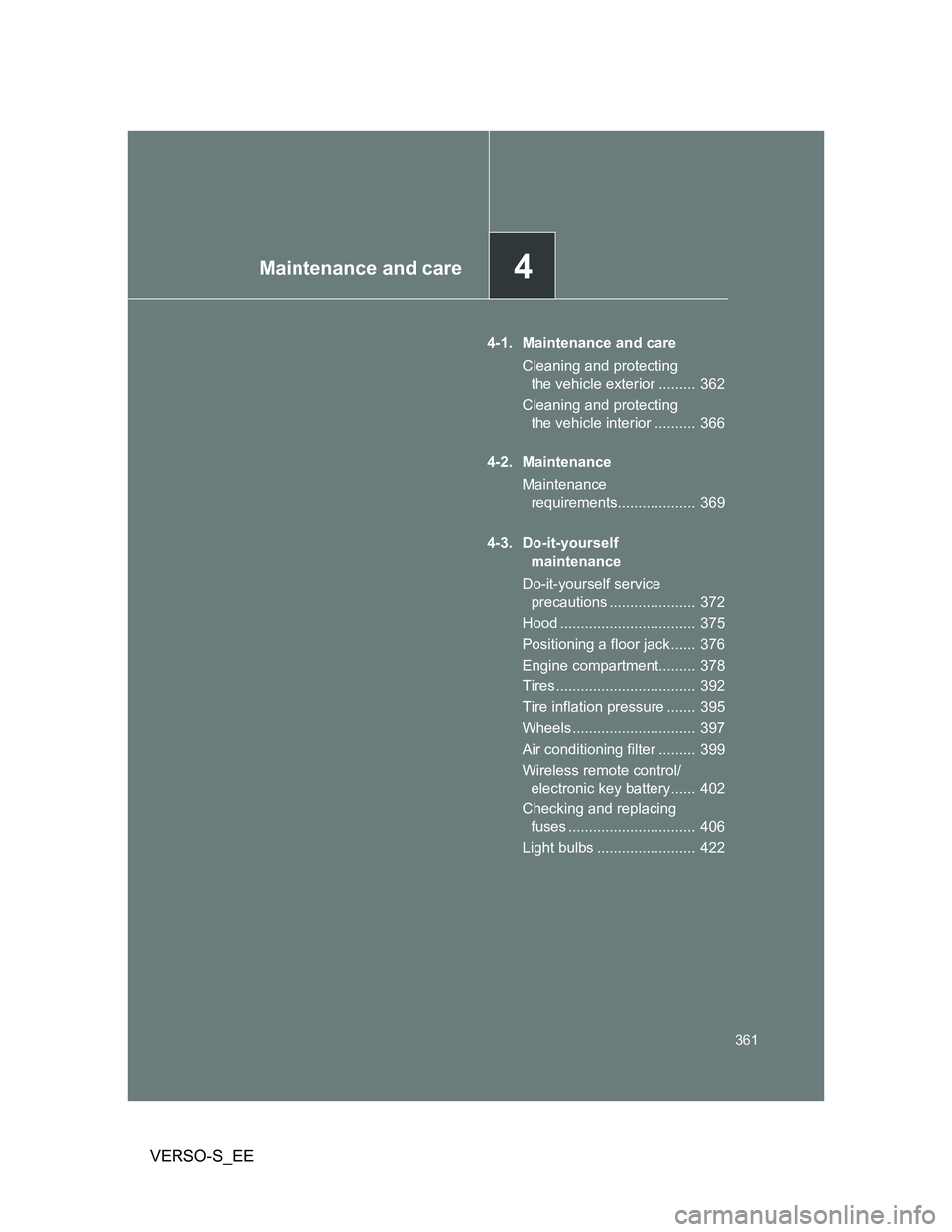
4Maintenance and care
361
VERSO-S_EE
4-1. Maintenance and care
Cleaning and protecting
the vehicle exterior ......... 362
Cleaning and protecting
the vehicle interior .......... 366
4-2. Maintenance
Maintenance
requirements................... 369
4-3. Do-it-yourself
maintenance
Do-it-yourself service
precautions ..................... 372
Hood ................................. 375
Positioning a floor jack ...... 376
Engine compartment......... 378
Tires .................................. 392
Tire inflation pressure ....... 395
Wheels .............................. 397
Air conditioning filter ......... 399
Wireless remote control/
electronic key battery...... 402
Checking and replacing
fuses ............................... 406
Light bulbs ........................ 422
Page 373 of 560
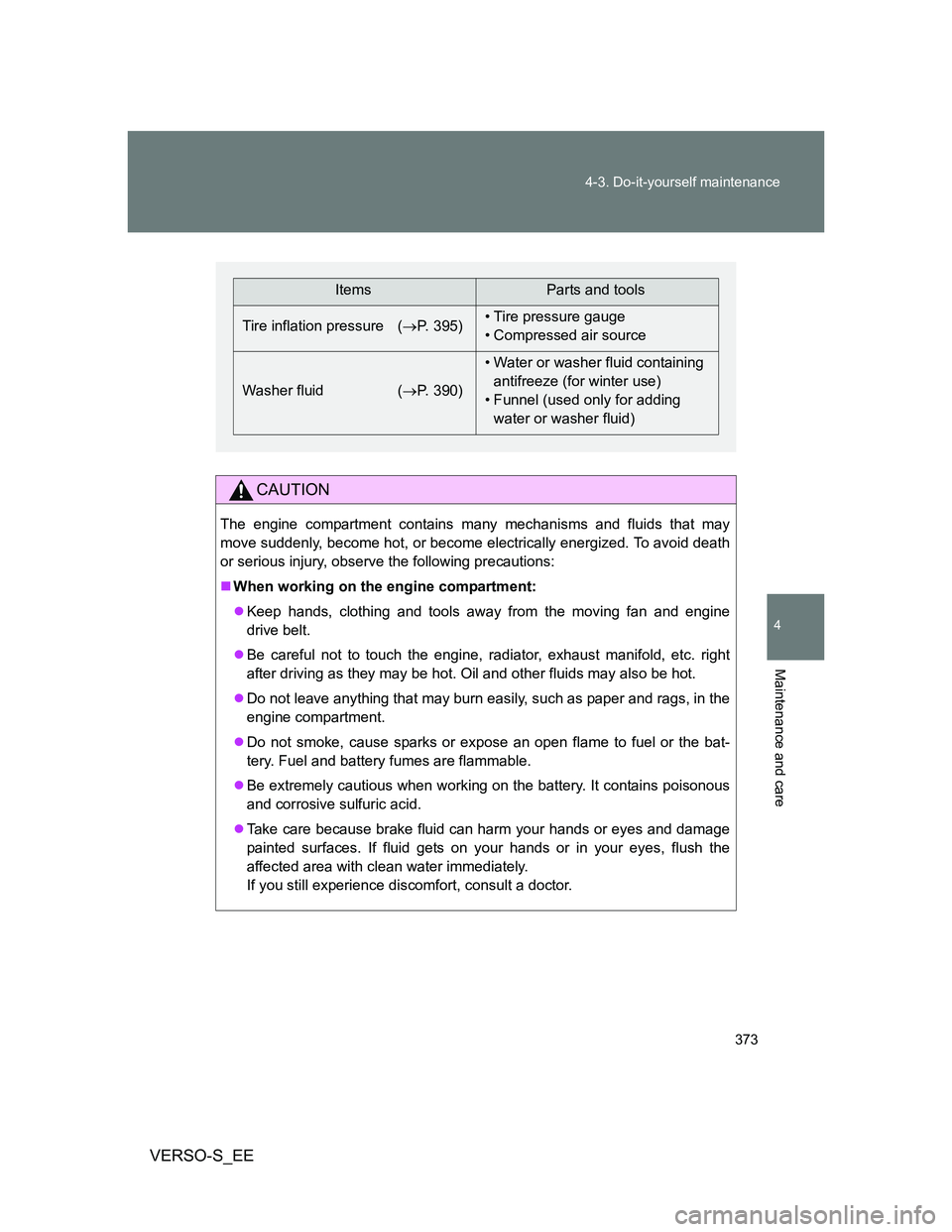
373 4-3. Do-it-yourself maintenance
4
Maintenance and care
VERSO-S_EE
CAUTION
The engine compartment contains many mechanisms and fluids that may
move suddenly, become hot, or become electrically energized. To avoid death
or serious injury, observe the following precautions:
When working on the engine compartment:
Keep hands, clothing and tools away from the moving fan and engine
drive belt.
Be careful not to touch the engine, radiator, exhaust manifold, etc. right
after driving as they may be hot. Oil and other fluids may also be hot.
Do not leave anything that may burn easily, such as paper and rags, in the
engine compartment.
Do not smoke, cause sparks or expose an open flame to fuel or the bat-
tery. Fuel and battery fumes are flammable.
Be extremely cautious when working on the battery. It contains poisonous
and corrosive sulfuric acid.
Take care because brake fluid can harm your hands or eyes and damage
painted surfaces. If fluid gets on your hands or in your eyes, flush the
affected area with clean water immediately.
If you still experience discomfort, consult a doctor.
ItemsParts and tools
Tire inflation pressure (P. 395)• Tire pressure gauge
• Compressed air source
Washer fluid (P. 390)• Water or washer fluid containing
antifreeze (for winter use)
• Funnel (used only for adding
water or washer fluid)
Page 392 of 560

392
4-3. Do-it-yourself maintenance
VERSO-S_EE
Tires
Replace or rotate tires in accordance with maintenance schedules
and treadwear.
Checking tires
New tread
Treadwear indicator
Worn tread
The location of treadwear indi-
cators is shown by the “TWI” or
“” marks, etc., molded on the
sidewall of each tire.
Check spare tire condition and
pressure if not rotated.
Tire rotation
Rotate the tires in the order
shown.
To equalize tire wear and help
extend tire life, Toyota recom-
mends that tire rotation is car-
ried out approximately every
10000 km (6000 miles).
Front
Page 394 of 560

394 4-3. Do-it-yourself maintenance
VERSO-S_EE
NOTICE
Driving on rough roads
Take particular care when driving on roads with loose surfaces or potholes.
These conditions may cause losses in tire inflation pressure, reducing the
cushioning ability of the tires. In addition, driving on rough roads may cause
damage to the tires themselves, as well as the vehicle’s wheels and body.
If tire inflation pressure of each tire becomes low while driving
Do not continue driving, or your tires and/or wheels may be ruined.
Page 395 of 560

395
4-3. Do-it-yourself maintenance
4
Maintenance and care
VERSO-S_EE
Tire inflation pressure
Effects of incorrect tire inflation pressure
Driving with incorrect tire inflation pressure may result in the following:
Reduced fuel efficiency
Reduced driving comfort and tire life
Reduced safety
Damage to the drive train
If a tire needs frequent inflating, have it checked by any authorized Toyota
dealer or repairer, or another duly qualified and equipped professional.
Instructions for checking tire inflation pressure
When checking tire inflation pressure, observe the following:
Check only when the tires are cold.
If your vehicle has been parked for at least 3 hours or has not been
driven for more than 1.5 km or 1 mile, you will get an accurate cold tire
inflation pressure reading.
Always use a tire pressure gauge.
The appearance of the tire can be misleading. In addition, tire inflation
pressure that is even just a few pounds off can affect ride quality and
handling.
Do not reduce tire inflation pressure after driving. It is normal for tire infla-
tion pressure to be higher after driving.
Never exceed the vehicle capacity weight.
Passengers and luggage weight should be placed so that the vehicle is
balanced.
Make sure to maintain proper tire inflation pressure. Tire inflation
pressure should be checked at least once per month. However,
Toyota recommends that tire inflation pressure be checked once
every two weeks. (P. 531)